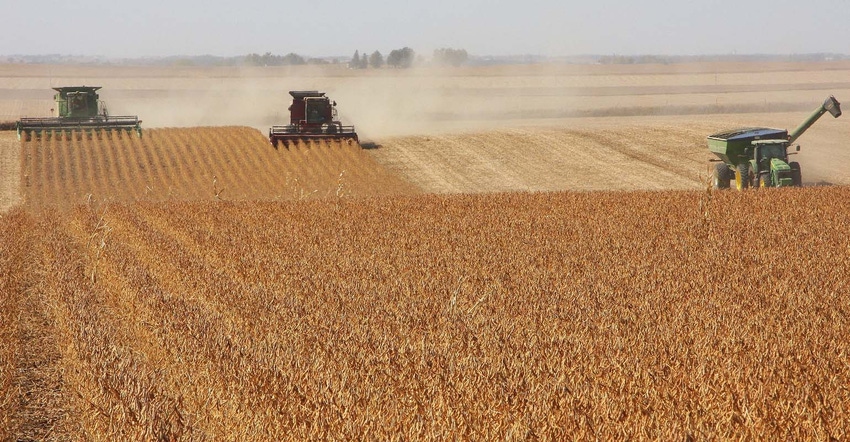
Author’s note: You can participate in the Feedback from the Field series as often as you’d like this growing season! Just click this link to take the survey and share updates about your farm’s spring progress. I review and upload results daily to the FFTF Google MyMap, so farmers can see others’ responses from across the country – or even across the county!
The most important insight I received from farmers over the past week about harvest progress?! A Washington barley producer reminded me not to forget about specialty crops in my reporting. Barley harvest is largely complete in Washington – as well as the rest of the country – so market focus is now turning to demand factors.
“Please observe Oktoberfest,” the Washington grower reminded me in what was likely my favorite reader exchange of the week. True to my German roots (and also my Irish heritage!), I already have observed it! But I encourage you all to do the same – responsibly, of course!
Corn harvest surges past the halfway mark
USDA’s weekly Crop Progress report released yesterday afternoon saw corn harvest break past the halfway mark through the week ending October 23. As of last Sunday, 61% of the anticipated 2022 U.S. corn crop had been harvested, up 16% from the previous week and marking the fastest weekly harvesting pace recorded so far this season as soybean harvest winded down and farmers turned their combine’s attention to corn.
Any potential harvest delays markets had been worried about prior to this point due to a slow start are no longer a concern. Yesterday’s harvest completion rate of 61% towered over the five-year average for the same reporting period of 52%. While widespread showers across the Corn Belt in coming days are expected to slow progress this week, mostly clear skies are forecast into next week, which should help coax the fast combine speeds along.
Rains in the Great Lakes region last week slowed harvest progress for some Feedback from the Field respondents. “Corn too wet,” an Eastern Wisconsin corn producer cited as the chief reason for slow harvest speeds in the Badger State.
Elsewhere around the Upper Midwest, growers are edging closer to wrapping up the 2022 growing season and have plenty to reflect on after a turbulent year. Here are a few insights:
“Good yields not great.” – Central Illinois
“I have drowned spots from all the spring rains.” – Northwestern Ohio
“All dryland burned up and unharvestable. Irrigated acres production down 30 to 40%.” – Western Kansas
“Very poor crop too dry.” – Southeast South Dakota
“Short on water.” – Northern Iowa
The market continues to miss the mark for USDA’s target on harvest paces, however. Prior to the report’s release, trade estimates had pegged the week’s harvest progress at 62% complete. USDA’s data came in 1% behind the trade estimates, which at the very least, helped limit corn’s losses during the overnight trading session.
Soybean harvest continues to blaze ahead
USDA reported soybean harvest at 80% complete as of October 23 in yesterday’s Crop Progress report, up 17% from the previous week and 13% ahead of the five-year average benchmark. Soybean harvest is quickly winding down across the country.
Once again, USDA’s reading surpassed the market’s expectations. Markets had been expecting USDA’s soybean harvest completion rate to be reported at 77% yesterday, so USDA’s reading of 80% was ahead of the curve. Soybean markets traded largely flat overnight, however, so the market miss did not appear to be impacting prices too significantly this morning.
Few FFTF growers have reported stellar yields, though the range of estimates varies significantly across the Heartland. Here are a few farmer comments from the past week:
“Yields were hurt due to drought.” Northern Minnesota
“Little below average.” Southeast South Dakota
“Average [yields].” Northern Iowa
“Average to slightly better [than corn yields].” Central Illinois
“Mostly doing well yield wish with 60 to 62 bpa. But have one field to harvest that had a lot of rain which will bring down the average.” Northwestern Ohio “Many farmers are finished in the area. Neighbor got almost 220 bpa corn and 65 bpa beans. Second crop beans after wheat got hit by frost while still very green. Time will tell how that affects yield.”
“About average yields mid 60’s.” Northern Illinois
Wheat still faces weather woes
Winter wheat sowing through the week of October 23 was reported by USDA in its weekly Crop Progress report yesterday at 79% complete, up just 10% from the prior week and just a scant 1% ahead of the five-year average for the same reporting period.
Markets had been expecting USDA’s reading to come in at 81%, though the slower than expected speeds could not offset market losses this morning. Planting delays due to dry soils in top producer Kansas were likely the chief driver of the market’s overestimation of wheat planting progress over the past week.
Emergence rates continue to struggle amid dry conditions across the entire U.S. Heartland. As of October 23, only 49% of the newly sown winter wheat crop had emerged, up 9% from the previous week but still 7% behind the five-year average.
Crop development has varied immensely across the country, especially in correlation to drought-stressed regions. “Wheat is looking great in our area,” shared an Eastern Wisconsin farmer. “Couldn’t have been [a] better [planting season],” exclaimed a Washington winter wheat grower.
But crops on the Plains continue to struggle amid lack of rainfall. A new record high of 82.2% of U.S. land was classified in some sort of abnormally dry to exceptional drought condition as of a week ago, which much of the drought damage currently centered over the Plains – the hotbed for hard red winter wheat production in the U.S.
“[We] cut back planted acres by 25% due to drought,” shared a Kansas wheat producer late last week. “Wheat has barely emerged and already showing signs of stress.”
About the Author(s)
You May Also Like






